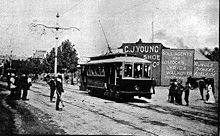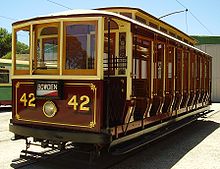- Municipal Tramways Trust
-
The Municipal Tramways Trust (MTT) was established in 1907 to operate Adelaide's street tram network. The MTT ceased to exist in 1975 upon the establishment of the State Transport Authority (STA) Bus and Tram Division.
Contents
History
The MTT was created as a tax exempt body with 8 members, mostly appointed by local councils and a small number of state government appointees.[1] They established a 9 acre (3.6 ha) tram depot site near the corner of Hackney and Botanic Roads Adelaide, this included a depot building, 24 incoming tracks and a large administration office[2]. William George Toop Goodman was appointed as its first engineer.
The MTT installed the first electric tramway in Adelaide in 1907 and Port Adelaide in 1917. The Adelaide-Glenelg railway was taken over by the MTT and in 1929 was turned into an electric tramway. The MTT throughout this period introduced a variety of bus services. In 1938 the Port Adelaide tram service was replaced by double-decker trolley buses. Goodman served the MTT for 42 years and was knighted in 1932, eventually retiring as general manager in 1950.[3][4]
Throughout the 1950s various tramways were replaced by diesel bus services. By 1958 Adelaide's Glenelg Tram was the last remaining service. The MTT continued to operate most of the local bus routes in the inner metropolitan area, often following former tram lines. By the 1970s the MTT had bought out many of the private bus operators then operating in the Adelaide suburbs.
In 1975 the services of the MTT became the Bus and Tram division of the State Transport Authority (STA). The STA was renamed TransAdelaide as part of the state government's privatisation programme of the 1990s and is now limited to operating Adelaide's tram and train services.
Inaugural MTT board members
When appointed in 1907 the MTT board consisted of:[5]
- Mr A B Moncrieff, Government appointee, chairman and engineer-in-chief.
- Mr Thomas Gill, Government appointee.
- Mr J R Baker, Alderman of the adelaide corporation.
- Mr Theodore Bruce, Mayor of Adelaide.
- Mr R Cruickshank, Mayor of St Peters.
- Mr H J Holden, Mayor of Kensington and Norwood.
- Mr J T Mellor, Mayor of Walkerville.
- Mr A C Sanders, Mayor of Prospect.
The board members were appointed for terms of six years with a provision that half the members should retire every three years.
Tram Depots
- City
- Hackney
- Maylands
- Prospect
- Port Adelaide
Equipment
'A' type
'A' type trams were the first electric trams to be used for public transport in Adelaide.
They were four-wheeler California 'combination' pattern. Combination meant a combination of half saloon (enclosed cabin) and half open space. The open crossbench seats at either end combined with the center saloon seated a total of forty passengers. A further sixty persons could be carried standing, making a 'crush load' of one hundred.
Seventy were built between 1908 and 1909 by local coachmakers Duncan & Fraser. They were fitted with running gear and electrical equipment from Britain and the USA.
They pioneered routes as they opened to Kensington, Marryatville, Maylands, Payneham, Walkerville, North Adelaide, Parkside, Unley and Hyde Park. Later on they were relegated to the quieter routes such as Corydon and Port Adelaide as larger trams became available and were gradually retired from the 1930s. The last 'A' type tram ran in 1952.
'B' type
Along with the seventy 'A' type trams, 30 four-wheel cars, with completely open sides and eventually to become known as 'toast-racks', were also purchased to start the system.
Being open to all weather they were not suitable for the colder times of the year. In 1926-7 twenty were enclosed and styled A1 and A2 type cars and one was converted to assist with track-work. The open cars carried fifty passengers seated and fifty standing (standees) making a crush-load of 100, same as the 'A' type trams.
The 'toast-rack' design of the cars made them popular during summer and were used to transport concert-goers to transit authority arranged concerts at Kensington Gardens as well as beach-side suburbs Henley and Semaphore. This arrangement added handsomely to the revenue of the transit authority.
Most of these trams were retired by the mid 1930s.
'C' type
During the First World War, the MTT urgently needed more tramcars due to passenger traffic increases with the line extensions. Twenty were built by Adelaide's Duncan & Fraser and carried 112 passengers, fifty seated and sixty-two standing and were considerably faster than the 'A' trams they were based on due to being fitted with a larger engine.
They became known as 'bouncing billies' because of their lack of air-brakes and safety concerns. It was because of this that MTT drivers went on strike.
'D' type
Between 1910 and 1912, seventy bogie cars were built by Adelaide coach builders Pengelly & Co and added to the MTT fleet to help service with the electric system.
When they were introduced, they were the largest public transport unit in operation and carried 154 passengers in total (fifty-four passengers seated and a further 100 standing). Fifty of these cars were styled 'D' types and officially known as 'Closed Combination Metropolitan Bogie Cars. 'Combination' referred to the half-enclosed half-open nature of the cabin design while 'Closed' referred to the sliding doors enclosing the 'open' section.
Four 'D' type trams were built by Duncan & Fraser in 1912 for a Melbourne tramway. The trams were retired by Melbourne & Metropolitan Tramways Board in an effort to standardise their fleet. These trams were returned to Adelaide and added to the existing 'D' type fleet.
Their high steps made them unpopular with travellers.
'D' type trams operated until 1958.
'E' type
Twenty of the 1910 seventy-car 'D' type order from Pengelly & Co were styled 'E' type. They were similar to the 'D' type trams except that the smoking section was more open and had less protection from the weather. The crossbench seats meant that the conductor had to collect fares from the footboard.
These cars were eventually used on the Glen Osmond - St. Peters line. Some survived until 1958. Like the 'D' type trams they carried fifty-four seated passengers and one hundred standing.
'F' type
Eighty-one 'F' type cars were built by Pengelly & Co and went into service in 1922 with three being built by MTT's own workshops.
'F' type trams were a highly popular design and provided much more space and comfort than the previous designs.
More modern running gear taking up less space meant the car body was lower to the ground making the tram easier to board and alight. 'F' type trams had seating for sixty and standing room for a further 110 standees.
These trams were used all over the network and especially well-suited to carry the large numbers of passengers associated with race meetings, football matches and the showground.
They remained in service until the end of the street tramway system in 1958.
'G' type
Four 'G' types were built by JG Brill of Philadelphia and assembled at the MTT workshops in Adelaide in 1935.
They operated from Port Adelaide to Semaphore, Largs, Rosewater and Albert Park and did not connect with the main tram system. They were also used in Geelong and Bendigo where they continued service until 1972 and remain on there as a tourism service.
'G' type trams were significantly smaller and lighter than other trams carrying only 50 passengers.
'H' type
Thirty large 'inter-urban' cars were delivered in 1929 by Pengelley & Co for use on the new Glenelg line and served for over seventy-five years.
They became known as 'Bay Trams' and were very popular. They were designed to run in two or three car sets. By the mid 1930s they only ran in one or two car sets.
'H' type trams ran until 1958. Five were refurbished and continue to run on the Glenelg line as a tourism attraction.
Notes
- ^ The Critic (1909), pp.15,17-18
- ^ The Critic (1909), p.27
- ^ McCarthy, G.J (22 June 2005). "Goodman, William George Toop (1872 - 1961)". Bright Sparcs. http://www.asap.unimelb.edu.au/bsparcs/biogs/P001252b.htm. Retrieved 2007-01-30.
- ^ "Adelaide's tramways". tramaus. http://hometown.aol.com.au/tramaus/Pages/adetrams.htm. Retrieved 2007-01-30.
- ^ The Critic (1909), pp.2,3,15,17,18
References
- The Critic (1909). The Tramways of Adelaide, past, present, and future : a complete illustrated and historical souvenir of the Adelaide tramways from the inception of the horse trams to the inauguration of the present magnificent electric trolley car system. Adelaide: The Critic.
Categories:- Transport in South Australia
Wikimedia Foundation. 2010.






